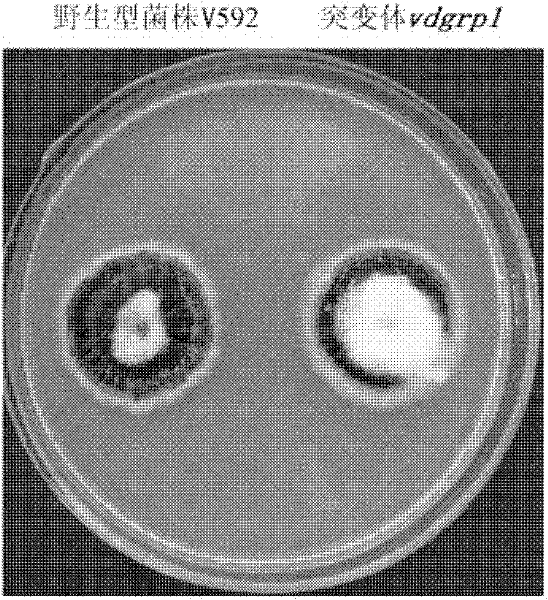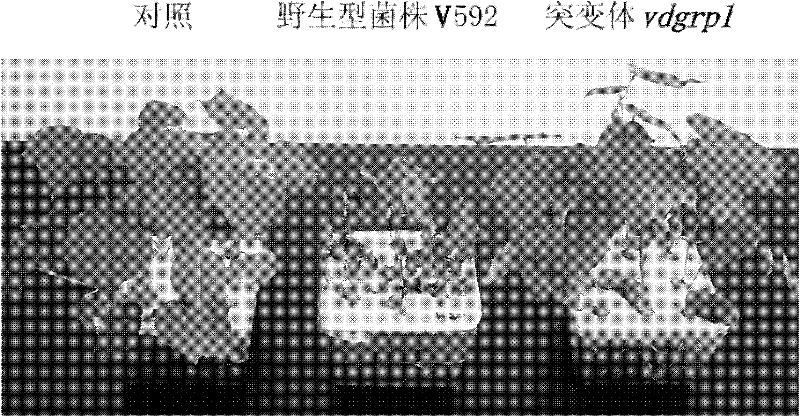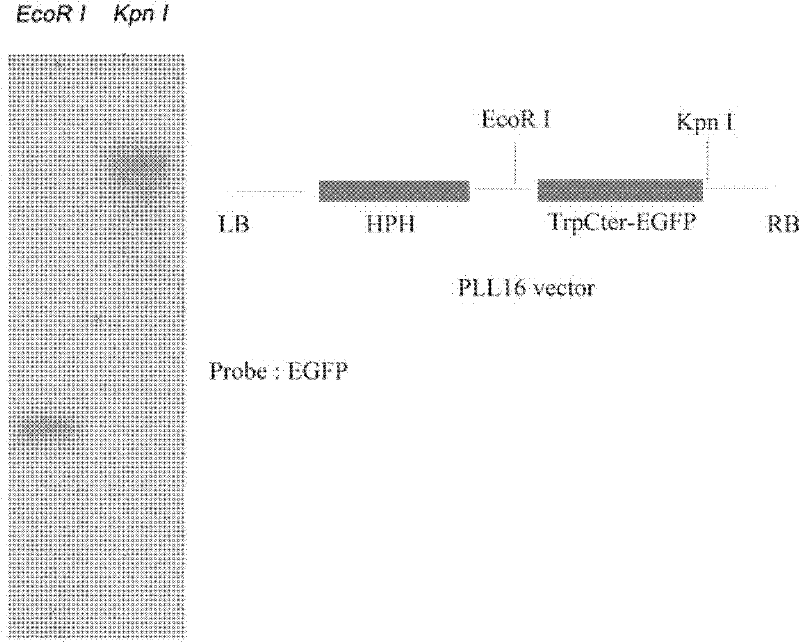Pathogenic related protein VdGRP1 from verticillium dahliae kleb and coded gene thereof
A technology that encodes genes and proteins. It can be used in genetic engineering, plant genetic improvement, and cells modified by introducing foreign genetic material. It can solve problems such as difficulties in genetic breeding for disease resistance, complex genetic background, and strong differentiation variability.
- Summary
- Abstract
- Description
- Claims
- Application Information
AI Technical Summary
Problems solved by technology
Method used
Image
Examples
Embodiment 1
[0047] Embodiment 1, the construction of Verticillium dahliae mutant library
[0048] Verticillium dahliae strain V592 (strain V592 was collected from a cotton field in Xinjiang, and the literature recording this material is a rapid detection of the pathogenic type of Verticillium dahliae in cotton plants. Xinjiang Agricultural Sciences 2010, 47(4): 827-831, The public can obtain it from the Institute of Microbiology, Chinese Academy of Sciences) after culturing on a PDA plate at 25°C, inoculate the spores in Cha's liquid medium (2g NaNO3, 1g KH 2 PO4, 1g MgSO 4 .7H 2 O, 1g KCl, 2mg FeSO 4 .7H 2 O and 30g sucrose / L) and cultured with shaking for 5-8 days until the spore concentration was 1.0×10 7 / mL, the spore culture solution was filtered through 4 layers of sterile gauze to remove mycelium. Centrifuge at 4000rpm for 10min to obtain spores and adjust the concentration of spores to 1.0×10 with induction medium plus AS (acetophthalate syringone) 200mM 6-7 / mL.
[0049] ...
Embodiment 2
[0050] Embodiment 2, the acquisition of mutant vdgrp1
[0051] The pathogenicity of the mutants was identified by infecting the hydroponic cotton with strains, so as to screen the mutants with altered pathogenicity. Select plump cotton seeds (Xinluzao-16, purchased from Agricultural College of Xinjiang Shihezi University), soak with 15% sodium hypochlorite for 30 minutes, rinse with sterile water for 2-3 times, then soak with sterile water to accelerate germination overnight and lay flat Moisturize in the culture box, wait for the buds to grow to 3cm, and plant them in the germination box. Drill holes with a diameter of 2 cm and a spacing of 3 cm on the foam board, wrap the root-bud junction of the germinated cotton with a sponge strip, and stuff it into the holes of the foam board. Place the foam plate on a plastic box (8-10 cm high) filled with clear water, and culture at 25° C. for 16 hours in the light and 8 hours in the dark. When the true leaves grow out, replace the c...
Embodiment 3
[0053] Embodiment 3, the acquisition of mutant gene
[0054] 1), Southern hybridization to determine the mutant T-DNA insertion copy number ( image 3 )
[0055] A, the extraction method of genomic DNA is as follows: In liquid Chapei culture medium, 200rpm shakes and cultivates mycelium. The cultured liquid was centrifuged at 10,000 rpm for 10 min and ground with liquid nitrogen. Add 500 μL of extraction buffer (100mmol / LTris-HCl, PH8.0, 100mmol / L EDTA, 250mmol / L NaCl), vortex to mix the bacterial powder and extraction buffer thoroughly, then add 50μL 20% SDS, shake the Eppendorf tube gently , mix the mixture evenly, put it in a water bath at 37°C for 1h, take it out and add 75L 5mol / L NaCl, mix gently, then add 65μL 10% CTAB and 0.75mol / LNaCl solution, mix gently, and then put it in 65°C Incubate in water for 20 min, take it out, add 700 μL of chloroform / isoamyl alcohol (24:1) solution, mix well, centrifuge at 12000 rpm for 12 min, take the supernatant, add 2 times the vol...
PUM
 Login to View More
Login to View More Abstract
Description
Claims
Application Information
 Login to View More
Login to View More - R&D
- Intellectual Property
- Life Sciences
- Materials
- Tech Scout
- Unparalleled Data Quality
- Higher Quality Content
- 60% Fewer Hallucinations
Browse by: Latest US Patents, China's latest patents, Technical Efficacy Thesaurus, Application Domain, Technology Topic, Popular Technical Reports.
© 2025 PatSnap. All rights reserved.Legal|Privacy policy|Modern Slavery Act Transparency Statement|Sitemap|About US| Contact US: help@patsnap.com



